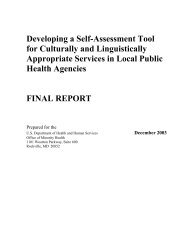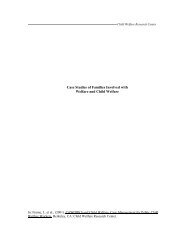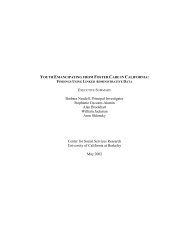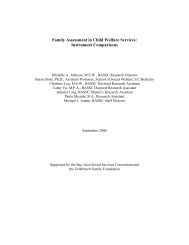Predictors of Resilience in Maltreated and Nonmaltreated Latino ...
Predictors of Resilience in Maltreated and Nonmaltreated Latino ...
Predictors of Resilience in Maltreated and Nonmaltreated Latino ...
Create successful ePaper yourself
Turn your PDF publications into a flip-book with our unique Google optimized e-Paper software.
children <strong>in</strong> the low adaptive function<strong>in</strong>g group were compared<br />
with all others, significantly more maltreated Lat<strong>in</strong>o children, 2 (1,<br />
N 133) 6.22, p .02, than nonmaltreated Lat<strong>in</strong>o children<br />
were <strong>in</strong> the low group.<br />
Predict<strong>in</strong>g Resilient Function<strong>in</strong>g<br />
In order to identify contributors to differences <strong>in</strong> resilient function<strong>in</strong>g<br />
among the Lat<strong>in</strong>o children, several process variables were<br />
evaluated as potential predictors <strong>of</strong> resilient function<strong>in</strong>g. Personal<br />
resource variables were assessed <strong>in</strong> these analyses, <strong>in</strong>clud<strong>in</strong>g egoresiliency,<br />
ego-control, <strong>and</strong> receptive vocabulary. In addition to the<br />
personal resource variables, aspects <strong>of</strong> <strong>in</strong>terpersonal relations that<br />
could serve to promote resilience among high-risk Lat<strong>in</strong>o children<br />
were evaluated. In particular, the ability <strong>of</strong> a child to form a<br />
positive relationship with the head camp counselor was assessed<br />
<strong>and</strong> considered an <strong>in</strong>dication <strong>of</strong> a child’s capacity to relate successfully<br />
to a new adult figure. Table 4 provides a summary <strong>of</strong><br />
each <strong>of</strong> these variables contrast<strong>in</strong>g maltreated <strong>and</strong> nonmaltreated<br />
Lat<strong>in</strong>o children. 2 A number <strong>of</strong> significant differences were found.<br />
Specifically, maltreated Lat<strong>in</strong>o children ev<strong>in</strong>ced lower levels <strong>of</strong><br />
ego-resiliency <strong>and</strong> receptive vocabulary than did nonmaltreated<br />
children. <strong>Maltreated</strong> Lat<strong>in</strong>o children also ev<strong>in</strong>ced marg<strong>in</strong>ally<br />
higher levels <strong>of</strong> ego-undercontrol than did nonmaltreated children.<br />
In terms <strong>of</strong> <strong>in</strong>terpersonal relationships, maltreated Lat<strong>in</strong>o children<br />
were rated by their counselors as more conflicted than were<br />
nonmaltreated children. Similarly, nonmaltreated Lat<strong>in</strong>o children,<br />
compared with maltreated children, were rated as be<strong>in</strong>g warmer,<br />
were rated as hav<strong>in</strong>g more open communication, <strong>and</strong> received<br />
higher total relationship scores, <strong>in</strong>dicat<strong>in</strong>g that the nonmaltreated<br />
children were better able to achieve positive relationships with<br />
their head counselors.<br />
In order to determ<strong>in</strong>e whether the process variables predicted<br />
resilient function<strong>in</strong>g <strong>and</strong> whether they related differentially to<br />
resilient function<strong>in</strong>g for maltreated <strong>and</strong> nonmaltreated Lat<strong>in</strong>o children,<br />
we conducted a series <strong>of</strong> hierarchical regressions. Gender<br />
was <strong>in</strong>cluded <strong>in</strong> the regression analyses to explore whether it<br />
contributed significantly to resilient function<strong>in</strong>g.<br />
Ego-Resiliency <strong>and</strong> Ego-Control<br />
In the first hierarchical regression analysis, resilient function<strong>in</strong>g<br />
total scores were regressed onto the predictor variables <strong>of</strong> ego-<br />
Table 2<br />
Comparisons <strong>of</strong> <strong>Maltreated</strong> <strong>and</strong> <strong>Nonmaltreated</strong> Lat<strong>in</strong>o Children<br />
on N<strong>in</strong>e Indicators <strong>of</strong> Resilient Function<strong>in</strong>g<br />
Indicator<br />
<strong>Maltreated</strong> <strong>Nonmaltreated</strong><br />
M SD M SD<br />
t (131) p<br />
Prosocial 0.27 0.82 0.26 0.95 3.48 .001<br />
Aggressive 0.16 0.93 0.20 0.80 2.33 .02<br />
Withdrawn 0.07 0.91 0.07 0.90 0.89 ns<br />
Cooperative 0.05 0.94 0.32 0.93 1.64 ns<br />
Disruptive 0.12 0.78 0.36 0.66 1.85 .06<br />
Shy 0.001 0.91 0.19 0.97 1.15 ns<br />
Fighter 0.05 0.88 0.38 0.56 2.61 .01<br />
Internaliz<strong>in</strong>g 53.12 8.08 49.71 8.20 2.39 .02<br />
Externaliz<strong>in</strong>g 57.11 8.79 52.49 8.24 3.08 .003<br />
<strong>Resilience</strong><br />
composite 2.61 1.93 3.61 2.23 2.79 .006<br />
PREDICTORS OF RESILIENCE IN LATINO CHILDREN<br />
Table 3<br />
Levels <strong>of</strong> Resilient Function<strong>in</strong>g by Maltreatment Status<br />
Resilient function<strong>in</strong>g<br />
<strong>Maltreated</strong> <strong>Nonmaltreated</strong> Total<br />
n % n % N %<br />
Low (0–1 <strong>in</strong>dicators) 30 39.5 11 19.3 41 30.8<br />
Middle (2–5 <strong>in</strong>dicators) 39 51.3 36 63.2 75 56.4<br />
High ( 6 <strong>in</strong>dicators) 7 9.2 10 17.5 17 12.8<br />
Total 76 57 133 100<br />
343<br />
resiliency <strong>and</strong> ego-control. In Steps 1 <strong>and</strong> 2 <strong>of</strong> the regression,<br />
maltreatment status <strong>and</strong> gender were entered followed by the ma<strong>in</strong><br />
effects <strong>of</strong> ego-resiliency <strong>and</strong> ego-control entered simultaneously at<br />
Step 3. Last, the l<strong>in</strong>ear <strong>in</strong>teractions between ego-resiliency <strong>and</strong><br />
maltreatment status <strong>and</strong> between ego-control <strong>and</strong> maltreatment<br />
status were entered simultaneously at Step 4. The unique contributions<br />
to the variance expla<strong>in</strong>ed (reported as sr 2 ) for each predictor<br />
variable are summarized <strong>in</strong> Table 5. The ma<strong>in</strong> effects <strong>of</strong><br />
maltreatment status, gender, ego-resiliency, <strong>and</strong> ego-control each<br />
made significant contributions to the prediction <strong>of</strong> resilient function<strong>in</strong>g,<br />
with ego-resiliency serv<strong>in</strong>g as the most powerful predictor.<br />
High ego-resiliency scores were associated with high resilience<br />
( .60), <strong>and</strong> high ego-undercontrol scores were associated<br />
with low resilience ( .17). Together these variables resulted<br />
<strong>in</strong> a highly significant regression equation, F(6, 126) 21.17, p <br />
.01, account<strong>in</strong>g for 50.2% <strong>of</strong> the variance <strong>in</strong> resilient function<strong>in</strong>g<br />
(adjusted R 2 .48).<br />
The l<strong>in</strong>ear <strong>in</strong>teractions <strong>of</strong> both ego-resiliency <strong>and</strong> ego-control<br />
with maltreatment status were found to be not significant. Because<br />
the personal resource variable <strong>of</strong> ego-control theoretically has a<br />
curvil<strong>in</strong>ear relation with adaptation <strong>and</strong> maladaptation (i.e., extreme<br />
ego-overcontrol <strong>and</strong> ego-undercontrol are associated with<br />
maladaptation; Kremen & Block, 1998), a separate analysis <strong>of</strong> a<br />
possible quadratic effect was evaluated for the <strong>in</strong>teraction <strong>of</strong><br />
maltreatment status <strong>and</strong> ego-control on resilient function<strong>in</strong>g. In<br />
Steps 1 <strong>and</strong> 2 <strong>of</strong> this analysis, the ma<strong>in</strong> effects <strong>of</strong> maltreatment<br />
status <strong>and</strong> ego-control were entered <strong>in</strong>to the regression equation,<br />
respectively, followed by the quadratic term <strong>of</strong> ego-control at Step<br />
3. Next, the product <strong>of</strong> ego-control <strong>and</strong> maltreatment was entered<br />
at Step 4 to evaluate the l<strong>in</strong>ear <strong>in</strong>teraction, followed by the product<br />
<strong>of</strong> maltreatment <strong>and</strong> the quadratic term for ego-control at the f<strong>in</strong>al<br />
step, to evaluate the quadratic <strong>in</strong>teraction. The ma<strong>in</strong> effects <strong>of</strong><br />
maltreatment status, ego-control, <strong>and</strong> the quadratic effect <strong>of</strong> egocontrol<br />
were significant, R 2 .21, F(3, 129) 11.46, p .01,<br />
together account<strong>in</strong>g for 21% <strong>of</strong> the variance <strong>in</strong> the resilient function<strong>in</strong>g<br />
composite. The l<strong>in</strong>ear <strong>and</strong> curvil<strong>in</strong>ear <strong>in</strong>teractions <strong>of</strong> mal-<br />
2 Twenty-eight children were miss<strong>in</strong>g <strong>in</strong>terpersonal relationship scores<br />
because <strong>in</strong> the early years <strong>of</strong> camp, the STRS measure was not adm<strong>in</strong>istered.<br />
In addition, 27 children were miss<strong>in</strong>g scores <strong>of</strong> receptive vocabulary<br />
because <strong>of</strong> issues such as absence from camp or concerns <strong>of</strong> validity. Thus,<br />
ow<strong>in</strong>g to differences <strong>in</strong> sample size result<strong>in</strong>g from miss<strong>in</strong>g data, <strong>in</strong>terpersonal<br />
relationship variables <strong>and</strong> personal resource variables were evaluated<br />
<strong>in</strong> separate hierarchical regression analyses. Receptive vocabulary, as<br />
measured by the PPVT–R, was not significantly correlated with scores <strong>of</strong><br />
resilient function<strong>in</strong>g (r .05); thus it was not <strong>in</strong>cluded as a variable <strong>in</strong> the<br />
regression analyses.

















